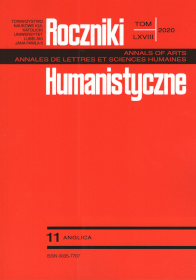The Concept of the Edge in the Plays of Marina Carr
Abstract
Women in the plays of Marina Carr have always been on the edge of something. The Mai suffers from the loss of selfhood and tries to escape the limitations imposed by her family, Portia fights for her right to be a mother who does not love her children, Hester cannot live outside the geographical limits of the bog that is killing her and Catherine will struggle to live in a dream.
The edge in Marina Carr’s theatre is a space that can be defined as a space of the mind, a space of resistance that her characters fight to inhabit. Edges constitute marginalized sites where women find a space of their own. In her latest plays the concept of the edge has been transferred to modern life and mythological rural landscapes have receded. Spaces of urban tension and conflict create edges that are now more visible on the stage through the dramatic space, and transformations occur in the form of provocative dialogues and behaviors that hint at a reinvented edge where women continue to search for their own spaces.
References
Carr, Marina. “Marina Carr in Conversation with Melissa Sihra.” Theatre Talk: Voices of Irish Theatre Practitioners, edited by Lilian Chambers et al., Carysfort Press, 2001, pp. 55–64.
Carr, Marina. Marble. The Gallery Press, 2009.
Carr, Marina. Marina Carr: Plays 1. Low in the Dark, The Mai, Portia Coughlan, By the Bog of Cats... Faber and Faber, 1999.
Foley, Anthony J., and Stephen Lalor, editors. Gill & Macmillan Annotated Constitution of Ireland. Gill and Macmillan, 1995.
Fouéré, Olwen. “Journeys in Performance.” The Theatre of Marina Carr, edited by Cathy Leeney and Anna McMullan, Carysfort Press, 2003, pp. 160–72.
Friel, Judy, and Sanford Sternlicht, editors. New Plays from the Abbey Theatre: Volume Two 1996–1998. New York, Syracuse UP, 2001.
Gardner, Lyn. “Death Becomes Her.” The Guardian, 29 Nov. 2004, www.theguardian.com/stage/ 2004/nov/29/theatre. Accessed 22 July 2020.
Heaney, Seamus. Finders Keepers: Selected Prose 1971–2001. Farrer Straus, 2002.
hooks, bell. “Choosing the Margin as a Place of Radical Openness.” Gender Space Architecture, edited by Jane Rendell et al., Routledge, 2000, pp. 203–9.
hooks, bell. Feminist Theory: From Margin to Center. South End Press, 2000.
Lefebvre, Henri. The Production of Space. Blackwell Publishing, 1984.
Leeney, Cathy. “Marina Carr: Violence and Destruction: Language, Space and Landscape.” A Companion to Modern British and Irish Drama 1880–2005, edited by Mary Luckhurst, Blackwell Publishing, 2008, pp. 509–18.
Lojek, Helen. The Spaces of Irish Drama. Stage and Place in Contemporary Plays. Palgrave Macmillan, 2011.
Massey, Doreen. Space, Place and Gender. Minneapolis, U of Minnesota P, 1994.
Novillo-Corvalán, Patricia. “The Theatre of Marina Carr: A Latin American Reading, Interview, and Translation.” Irish Migration Studies in Latin America, vol. 7, no. 2, 2009, pp. 145–55.
O’Toole, Fintan. “Figures on a Dark Landscape.” The Irish Times, 2 Apr. 1996, p. 10.
Roche, Anthony. “Woman on the Threshold: J. M. Synge’s The Shadow of the Glen, Teresa Deevy’s Katie Roche, and Marina Carr’s The Mai.” The Theatre of Marina Carr, edited by Cathy Leeney and Anna McMullan, Carysfort Press, 2003, pp. 17–43.
Sihra, Melissa. “Nature Noble or Ignoble: Woman, Family and Home in the Theatre of Marina Carr.” Hungarian Journal of English and American Studies (HJEAS), vol. 11, no. 2, Fall 2005, pp. 133–47.
Sihra, Melissa, editor. Women in Irish Drama: A Century of Authorship and Representation. Palgrave Macmillan, 2007.
Copyright (c) 2020 Roczniki Humanistyczne

This work is licensed under a Creative Commons Attribution-NonCommercial-NoDerivatives 4.0 International License.





